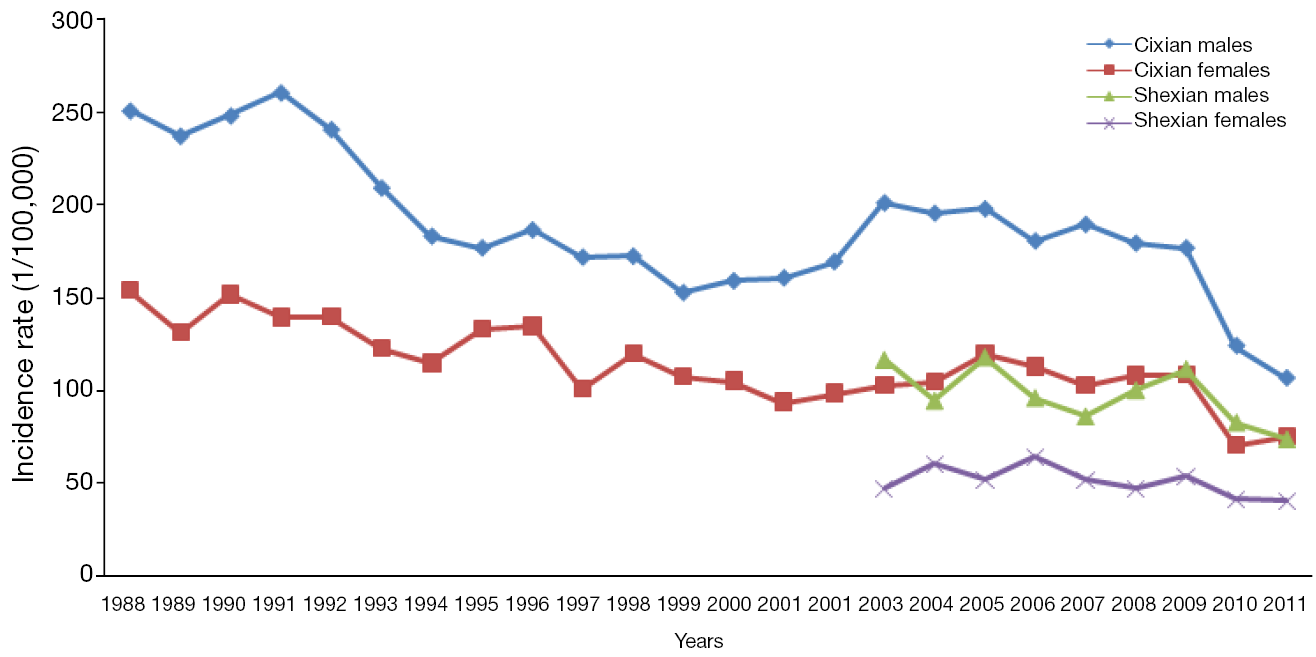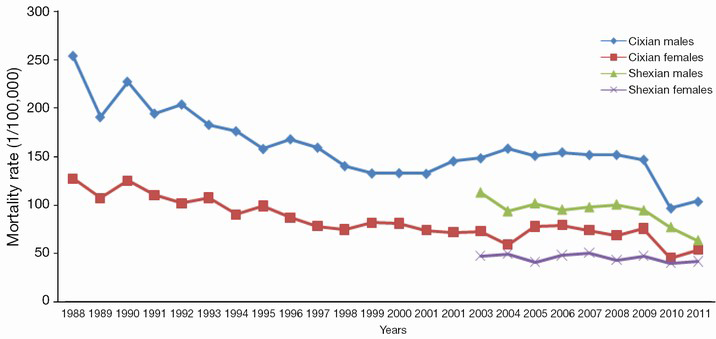Incidence and mortality rate of esophageal cancer has decreased during past 40 years in Hebei Province, China
Introduction
Esophageal cancer is a common cancer, with a 5-year relative survival rate of approximately 20.0% (1). According to GLOBOCAN, the estimated incidence rate of esophageal cancer in China was 12.6/100,000 in 2012, which was approximately twice as high as the worldwide average (5.9/100,000) (2). Hebei province is located in North of China with of approximately 6% of whole national population. It is one of the high-risk areas for esophageal cancer in China. In particular, the incidence and mortality rates in two counties of Hebei Province, Cixian and Shexian, are among the highest in the world (3,4). The earliest population-based registry was established in 1974 in Cixian. Shexian had its own population-based registry in 2000, and another six population-based cancer registries have been established since 2010. In total, the eight cancer registries covered a population of 4,573,293, which represented approximately 6.37% of the entire population in Hebei Province in 2011 (5,6). Moreover, Hebei Province participated in three national death surveys conducted during the periods 1973-1975 (7), 1990-1992 (8,9), and 2004-2005 (10).
To provide basic information on preventing and controlling esophageal cancer, we reported the burden of esophageal cancer in Hebei Province in 2011, and we examined trends in the mortality rates of esophageal cancer from 1973-1975 to 2004-2005. Additionally, we examined the trend in the incidence and mortality rates of esophageal cancer for two high-risk areas: Cixian (1988-2011) and Shexian (2003-2011).
Materials and methods
Data source
Cancer registry data
The Cixian cancer registration was established in 1974. The incidence and mortality rate data were published in Cancer Incidence in Five Continents (CI5VIII and CI5X) (11,12). The Shexian cancer registry was established in 2000, and the data were published in the Chinese Cancer Registry Annual Report (2008-2013). We extracted incidence and mortality data on esophageal cancer from 1988 to 2011 in Cixian and from 2003 to 2011 in Shexian. After 2010, eight cancer registries have been established in Hebei Province. Hebei Provincial Cancer Registry Center is responsible for compiling cancer data collection, evaluations and publications from local population-based cancer registries. The cancer information was reported to the cancer registries by local hospitals and community health centers, including the Basic Medical Insurances for Urban Residents and the New-Rural Cooperative Medical System. The Vital Statistical Database was linked to the cancer incidence database to identify cases with death certificates only (DCO) and follow-ups. By June 1, 2014, eight cancer registries submitted 2011 data to Hebei Provincial Cancer Registry Center. All cancer cases were classified according to the International Classification of Diseases for Oncology, 3rd edition (ICD-O-3), and the International Statistical Classification of Diseases and Related Health Problems 10th Revision (ICD-10). Invasive cases of esophageal cancer (ICD10: C15) were extracted and analyzed from the overall cancer database.
Quality control
According to “Guideline of Chinese Cancer Registration”, we checked the data quality using the inclusion criteria from “Cancer Incidence in Five Continents Volume X” (12), which was required by the International Agency for Cancer Registry (IACR) and the International Agency for Research on Cancer (IARC) (13). To check and evaluate the data, we used software, such as MS-Excel, SAS, and IARC Tools, which were issued by the International Agency for Research on Cancer/the International Association of Cancer Registries (IARC/IACR). The data were included in the present analysis if they met the following criteria: the morphological verification (MV%) was higher than 66%, the percentage of cancer cases identified with death certification only (DCO%) was less than 15%, and the mortality to incidence ratio (M/I) was between 0.6 and 0.8.
National retrospective survey of mortality
In the mid-1970s, a nationwide retrospective survey of the causes of mortality from 56 diseases (with a special emphasis on cancer), which was organized by the National Office for Cancer Prevention and Control, was conducted in 29 provinces, including Hebei Province. This survey covered all 153 cities and counties in Hebei Province. For the first time, it provided the national profiles and patterns of cancer mortality, as well as the total mortality rate in Hebei Province (7).
A national retrospective sampling survey of cancer mortality from 1990 to 1992 was organized by the National Office for Cancer Prevention and Control, the Ministry of Public Health, China. This survey employed a stratified sampling method, and covered approximately 10% of the population in China. A total of 21 cities and counties from Hebei Province were enrolled as sampling areas (8,9).
A national retrospective stratified sampling survey of all causes of death for the period 2004-2005 was organized by the Ministry of Public Health of China and the Ministry of Science and Technology of China. The survey was performed in 31 provinces/municipalities/autonomous regions, including Hebei Province in 2006 (10). A total of 18 cities and counties were selected as sampling areas, with a total population of 13,791,868 (20.15% of the total population of Hebei Province).
Statistical analysis
Incidence and mortality rates were calculated by gender and age groups. The numbers of new cases and deaths were estimated using the 5-year age-specific cancer incidence/mortality rates and the corresponding populations. The World Segi’s populations were used for the age-standardized rates. The cumulative risk of developing or dying from cancer before 75 years of age was calculated and presented as a percentage. SAS software was used to calculate the incidence and mortality rates. Long-term trends in age-standardized rates of esophageal cancer in Cixian and Shexian were analyzed using Joinpoint regression model (14). Joinpoint regression software (version 4.0.4) developed by the US National Cancer Institute was used.
Results
Quality evaluation
The coverage population of all eight cancer registries was 4,573,293. The M/I of esophageal cancer in all cancer registry areas was 0.75 (0.74 in males and 0.76 in females). The MV% was 75.5% (75.3% in males and 75.9% in females). The percentage of cancer cases identified with DCO% was 1.5% (1.3% in males and 1.8% females).
A total of 84.7%, 93.5%, and 95.8% of esophageal cancer cases were diagnosed by the county hospital level or above in the surveys dated 1973-1975, 1990-1992, and 2004-2005, respectively. Fewer than 2.5% of esophageal cancer cases did not have clinical diagnosis materials, and over 94.6% of the causes of death were confirmed by clinical diagnoses or other advanced technologies in all three mortality surveys.
Overall incidence and mortality rate in Hebei Province in 2011
In 2011, there were approximately 24,318 esophageal cancer cases in Hebei Province, accounting for 13.54% of all cancer cases. The crude incidence rate of esophageal cancer in the registry areas was 33.37/100,000 (42.18/100,000 for males and 24.31/100,000 for females). The ASRW was 28.09/100,000, which was 1.8 times and 4.8 times higher compared with the level of China and the world, respectively. ASRW was 37.38/100,000 and 19.53/100,000 for males and females, respectively (Table 1).
In 2011, 18,226 esophageal cancer deaths were estimated in Hebei Province, and the crude mortality rate was 25.01/100,000. It was 31.40/100,000 in males and 18.45/100,000 in females. The ASRW was 21.99/100,000, which was 2.0 and 4.4 times higher relative to the average level of China and the world. The ASRW of males was 29.71/100,000 and that of females was 15.35/100,000 (Table 1).

Full table
The mortality trend of esophageal cancer in Hebei Province
The mortality rate of esophageal cancer displayed a significant decreasing trend in Hebei Province from 1973-1975 to 2004-2005. In 1973-1975, the crude mortality rate of esophageal cancer was 30.85/100,000 (males 41.63, females 19.60), and it declined to 21.86/100,000 with 28.89 and 14.43 per 100,000 for males and females in 2004-2005. For the 1973-1975 period, the ASRW of esophageal cancer was 48.69/100,000 (male 67.54, female 30.40), accounting for 31.32% of cancer deaths, ranking in first place. For 1990-1992, the ASRW was 47.35/100,000 (male 65.34, female 31.02), accounting for 24.33% and ranking first all cancer deaths. The ASRW of esophageal cancer was 28.02/100,000 (male 38.81, female 17.89), with 16.37% and ranking third among total cancer deaths in 2004-2005, and the mortality rate decreased by 42.5% compared with 1973-1975. The age-adjusted mortality rate was descending as a whole and an equal trend was observed for males and females during the study period (Table 2, Figure 1).

Full table
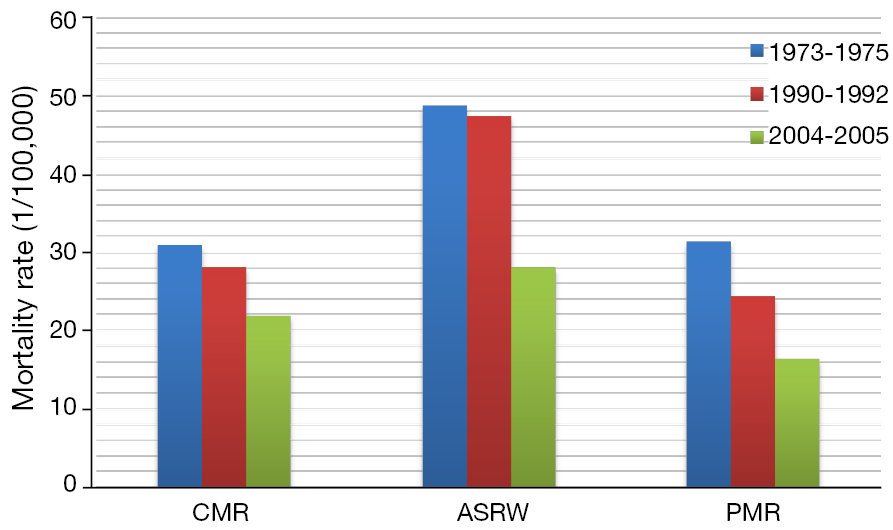
Age specific mortality of esophageal cancer in Hebei Province from 1973-1975 to 2004-2005
The age-specific mortality rate was low before 40 years of age and began to increase thereafter; for male, the mortality rates peaked in the 70-year-old age group which was 469.90 per 100,000 in 1990-1992, while they peaked at the 80+ age group (430.38 and 336.96 per 100,000 in 1974-1976 and 2004-2005). For females, as well as the male, the top of mortality rate of esophageal cancer appeared in the 80+ age group, except in 1990-1992, during which the top of mortality rate was observed in the 70-year age group (Table 3).
The age-specific mortality trends of 1973-1975 and 1990-1992 were similar, while the trend of 2004-2005 was similar to both of them, but the mortality was much lower. There was a significant decrease in the mortality trend in all age groups, especially among middle-aged people between 40 to 65 years old, who showed a nearly 50% decreased rate; the greatest decreases were observed in the 40-age group with 63.5% and 73.1% decreases for males and females. There was a slight decreasing trend in other age groups in 2004-2005 compared with 1973-1975 (Table 3, Figure 2).
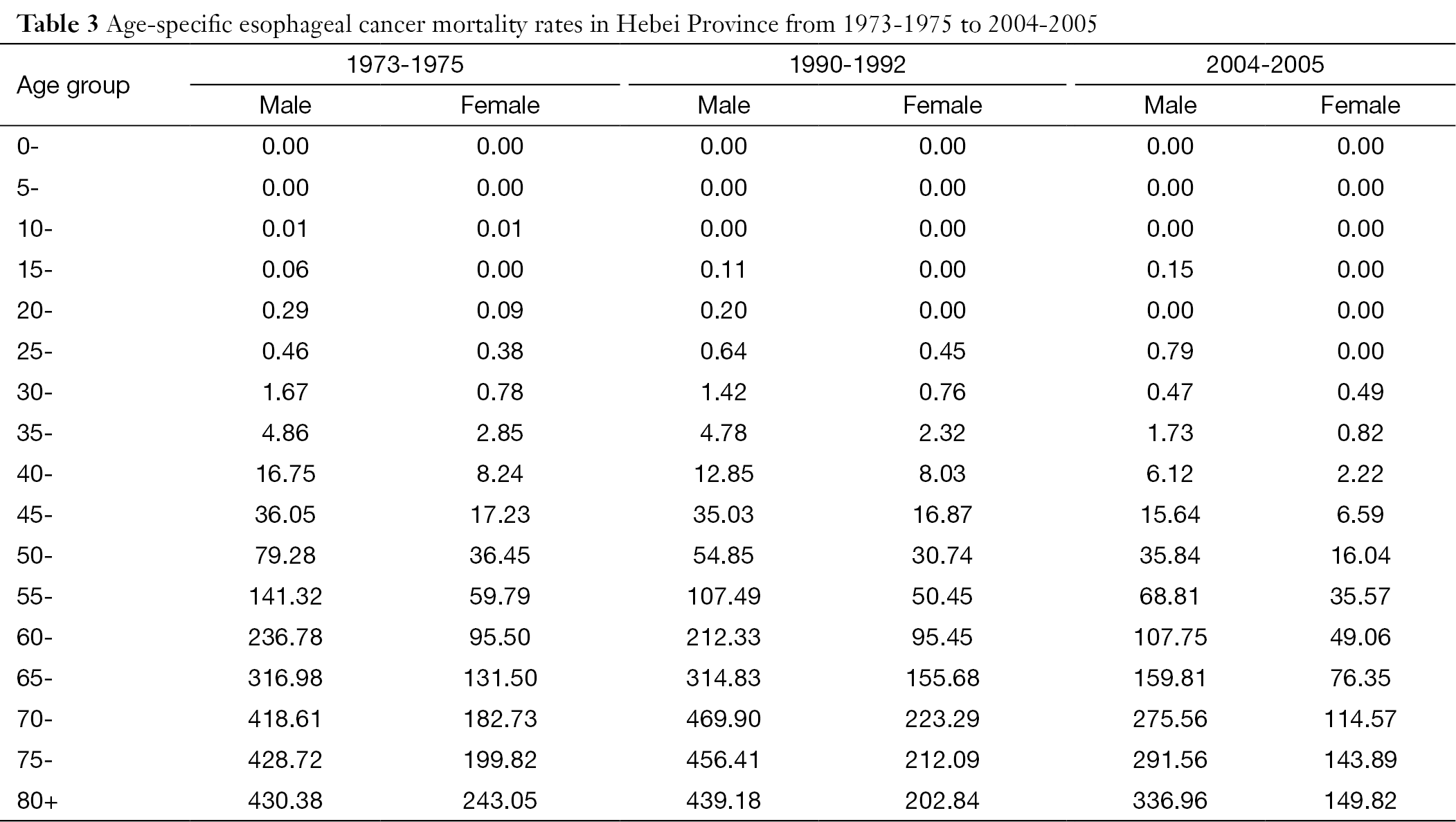
Full table
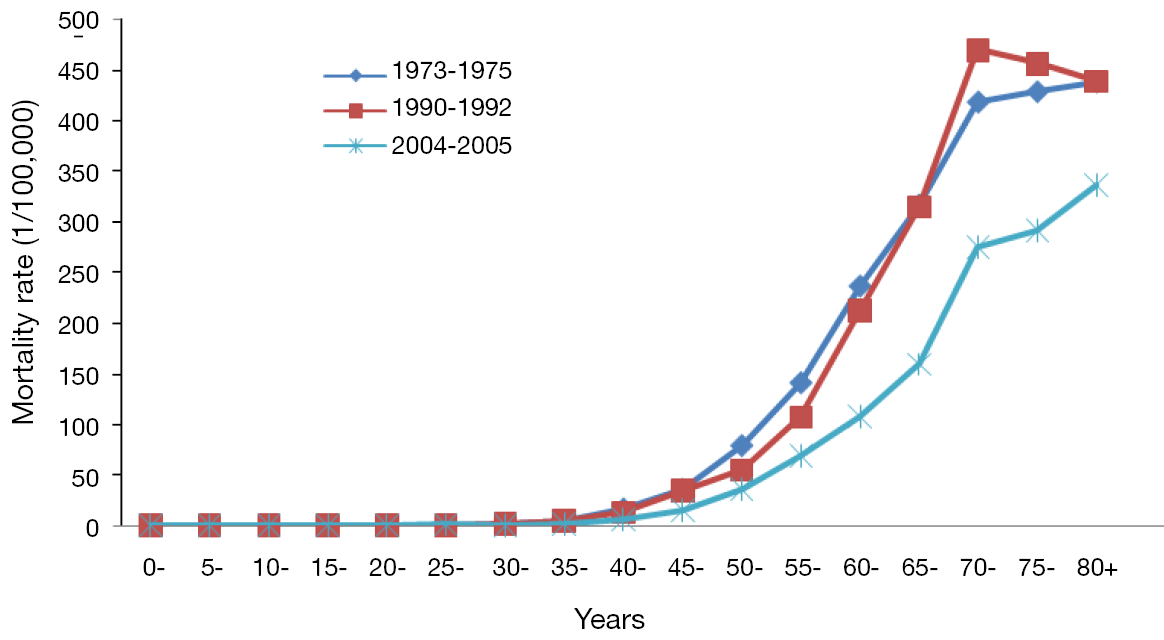
Trends of incidence rates of esophageal cancer in the high-risk regions of Cixian (1988-2011) and Shexian (2003-2011) in Hebei Province
The incidence rate of esophageal cancer has noticeably decreased in the high-risk region of Cixian in Hebei Province (Table 4, Figure 3). In 1988, the age-adjusted esophageal cancer incidence rate of males in Cixian was 250.76/100,000; it declined to 106.74/100,000 in 2011, representing a decrease of 57.4%. For females, the age-adjusted incidence rate was 153.86/100,000 in 1988, and it declined to 75.41/100,000 in 2011, revealing a decreased rate of 51.0%. There was a decreasing trend for the age-adjusted incidence rate of esophageal cancer in Cixian during the period 1988-2011, with annual percentage change (APC) of 2.13 and 2.16 in males and females, respectively.
We can also see a similar trend in Shexian (Table 5, Figure 3). For males, the incidence rate declined from 116.90/100,000 to 74.12/100,000 during 2003 to 2011, and for females, the rate declined from 46.98/100,000 to 40.64/100,000; thus, the decrease in rates were 36.6% and 13.5%, respectively, with APC of 3.74 and 3.21, but showed no statically significant difference.
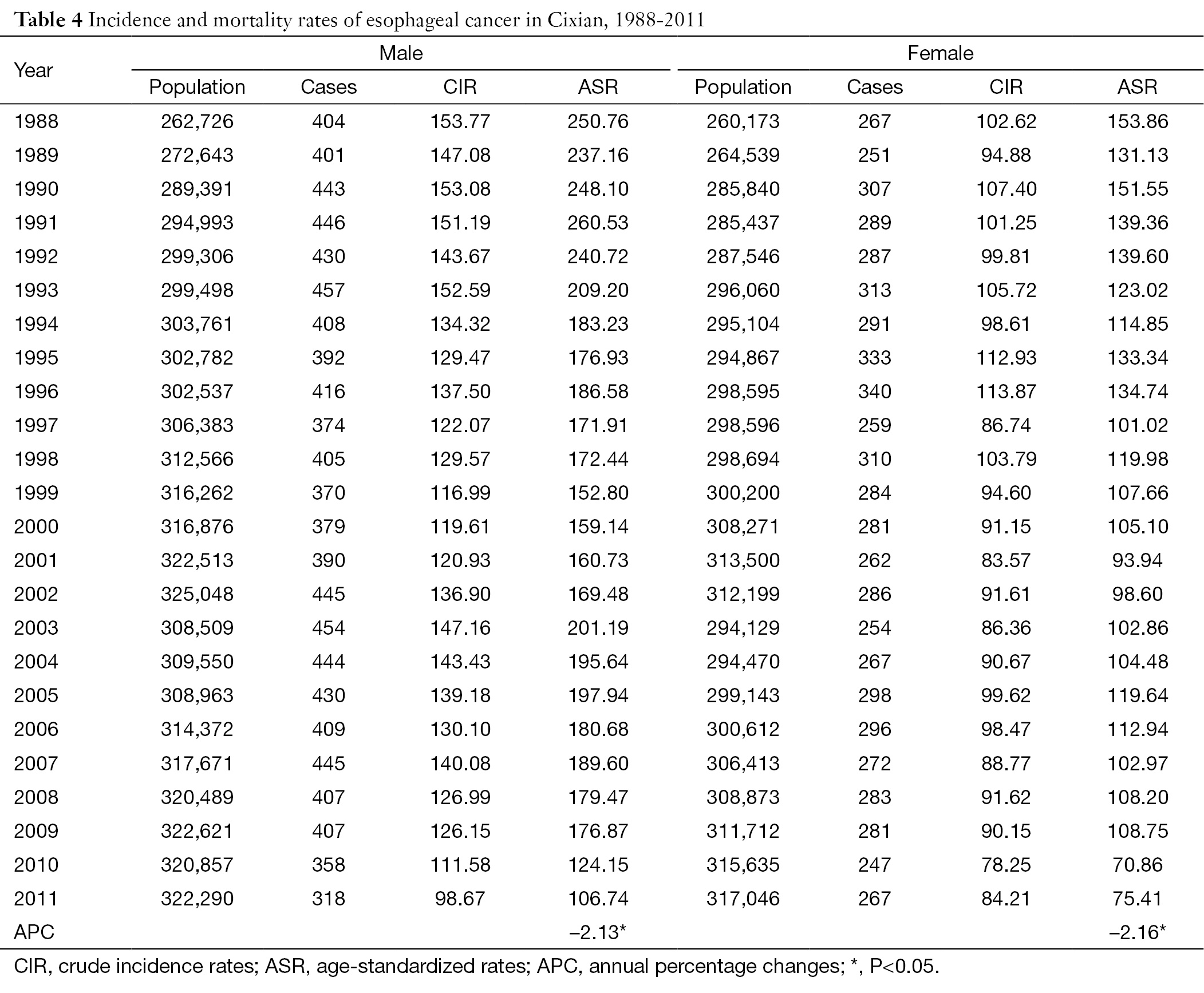
Full table
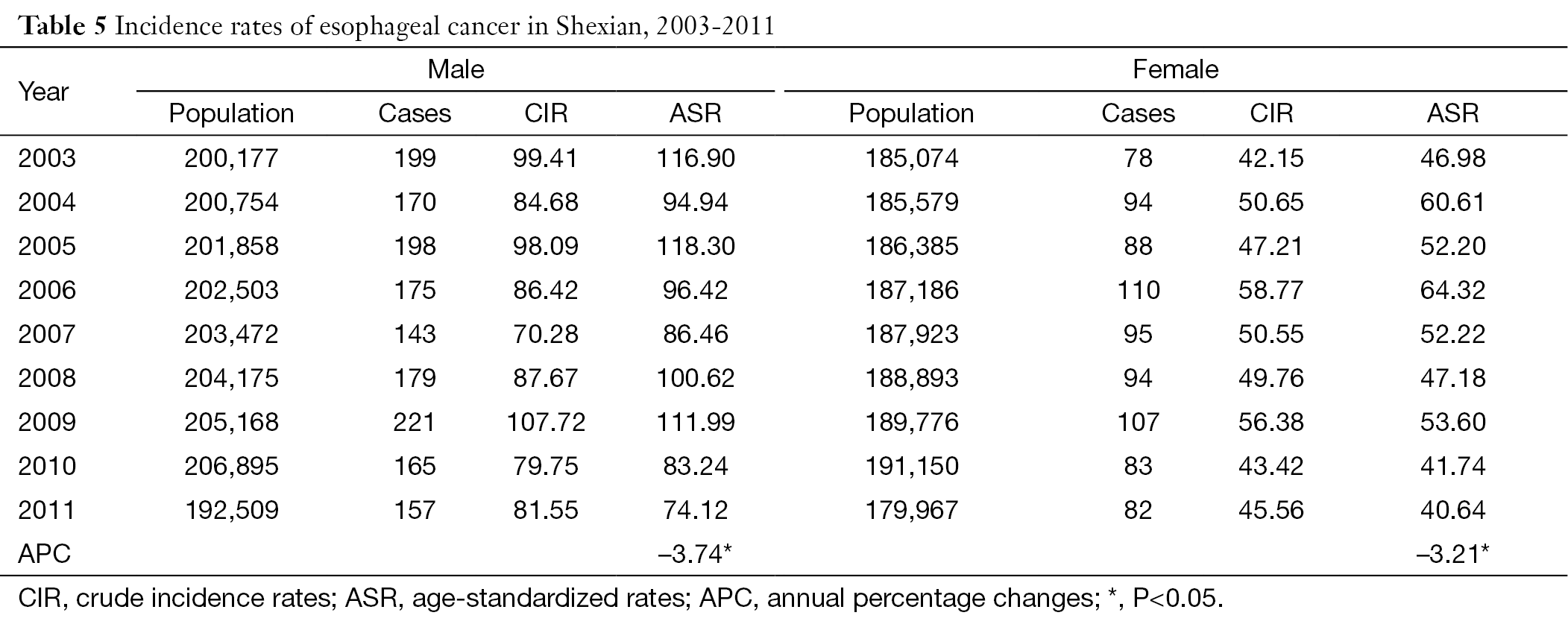
Full table
Trends of mortality rates of esophageal cancer in high-risk regions of Cixian (1988-2011) and Shexian (2003-2011) in Hebei Province
The mortality rate of esophageal cancer has decreased in the high risk region of Cixian in Hebei Province as the incidence rate showed (Figure 4). In 1988, the age-adjusted esophageal cancer mortality rate of males in Cixian was 252.50/100,000; it declined to 103.07/100,000 in 2011, representing a decrease of 58.5%. For females, the age-adjusted mortality rate was 126.74/100,000 in 1988, and it declined to 53.52/100,000 in 2011, revealing a decrease of 57.8%. A significant decreasing trend in the age-adjusted mortality rate of esophageal cancer was found in Cixian during the period 1988-2011, with APC of 2.46 and 3.10 for males and females, respectively.
The mortality rate of esophageal cancer in Shexian also presented a decreasing trend (Figure 4). For males, the mortality rate declined from 112.6/100,000 to 62.91/100,000 during 2003-2011 with a 44.1% decreased rate and with APC of 4.89. For females, the mortality rate went from 47.33/100,000 to 41.46/100,000, revealing a decrease of 12.4% and with APC of 1.65, but showed no statically significant difference.
Discussion
Esophageal cancer is one of the most common cancers in the world. With an estimated 456,000 new cases and 400,000 deaths, esophageal cancer was the eighth most common cancer and the sixth leading cause of cancer deaths worldwide in 2012 (2). Although the incidence and mortality rates have been stable or have declined slightly (15), esophageal cancer remains an important public health burden worldwide. The incidence of esophageal cancer varies widely across regions, ranging from 3 per 100,000 in low incidence areas to over 100 per 100,000 in high incidence regions. There are approximately 223,000 new cases and 197,200 deaths in China, accounting for 52.8% of incidence and 49.3% of mortality in the whole world. Hebei Province has high incidence regions of esophageal cancer. In particular, Cixian and Shexian have some of the highest rates of esophageal cancer. The ASRW was 28.09/100,000 in Hebei Province in 2011, which was 1.8 and 4.8 times higher compared with the overall rates in China and worldwide. The most recent cancer statistics on esophageal cancer might provide basic information for esophageal cancer prevention and control. The data showed that Hebei Province still suffers a great disease burden from esophageal cancer.
Esophageal cancer is a multifactorial disease, with a complex interaction between genetic and environmental factors. However, the exact mechanism underlying esophageal cancer is still unclear. The risk factors of esophageal cancer differ in different countries and regions. In developing countries, nitrosamine, lack of nutrition, unhealthy lifestyles and smoking are the main risk factors. Nitrosamine is a potent carcinogen, and its precursors (nitrate, nitrite-nitrogen and secondary ammonia) are widely present in air, water and food in high-risk areas. Liang et al. found that the level of nitrate, nitrite nitrogen and ammonia in high-risk areas exceeded the national standards for drinking water, which were 7 times higher than in low-risk regions (16). The residents of high-risk areas often eat pickled food, which could convert nitrates to nitrites and induce synthesis of N-nitrosamines. Islami F et al. showed a significant association between consuming pickled vegetables and esophageal cancer risk, with an OR of 2.08 (95% CI, 1.66-2.60) (17). Several studies have suggested that the intake of fruits and vegetables was associated with the decreased risk of esophageal cancer (18,19). The consumption of vegetables and fruits was much lower in high-risk areas, and the esophageal cancer burden may contribute to it. In addition, local traditional dietary habits, such as drinking hot soup and eating with squatting posture, may be associated with an increased risk of esophageal cancer. Lin J et al. reported that regular consumption of hot food was a risk factor for esophageal cancer (OR, 4.13; 95% CI: 2.13-8.0 5) (20). In a study addressing the attributable causes of esophageal cancer incidence and mortality in China, smoking tobacco, drinking alcohol, and a low intake of fruits and vegetables accounted for 46% of the esophageal cancer mortality and incidence rates in 2005 (21).
China’s mortality rates have decreased somewhat over the past three decades due to improvements in socio-economic status and lifestyles. According to data from The Third National Causes of Death Sampling Survey (2004-2005), the mortality rate has declined by 33.6% and 41.6% compared with the second survey in 1990-1992 and the first survey in 1973-1975, respectively (22,23). The mortality rate of esophageal cancer in Hebei Province also showed a significant decreasing trend. The mortality rate of 2004-2005 decreased by 40.82% and 42.45% compared with 1990-1992 and 1973-1975. The ASRW of esophageal cancer in Hebei Province in 1973-1975 and 1990-1992 both ranked first among all cancers, and it declined to the third place in 2004-2005. In addition, the proportional mortality ratio of esophageal cancer among all cancers declined from 1973-1975 (31.3%), 1990-1992 (24.3%) and 2004-2005 (16.4%). Furthermore, there was a significant decrease trend in middle-aged people between 40 and 65 years old from 1973-1975 and 2004-2005, with a nearly 50% decrease, particularly in the 40-year-old group, with 63.5% and 73.1% decreases for males and females, respectively. Thus, the median age of esophageal cancer death increased during this period. The same decreasing trend in the mortality rate of esophageal cancer was observed in Cixian (1988-2011), with APC of 2.5 and 3.1 for males and females, respectively, while in Shexian (2003-2011), there were APC of 4.89 for males and 1.65 for females, respectively. For mortality trends, the incidence of Cixian and Shexian also showed a decreasing trend during our study period (24).
The first death-cause survey in 1973-1975 showed the distribution of mortality of esophageal cancer had remarkable geographic variations and, thus, identified many high-risk areas, such as Cixian and Shexian. Since then, esophageal cancer prevention and control fields have been established in both counties. Experts specializing in epidemiology, clinical and basic research worked together to perform various intervention studies to control cancer rates. The reasons for the decreasing mortality from esophageal cancer were not well understood, potentially for the following reasons: for nearly 40 years, a great deal of cancer control work has been performed in these areas to control the risk factors, including (I) improving the quality of the drinking water by decreasing the pollution of nitrosamine; (II) administering the storage of agricultural products and advocating that people expose grain and drinking water to the sunshine; (III) avoiding food contaminated by mold; (IV) eating more vegetables and fruits; (V) modifying unfavorable lifestyles; and (VI) providing health education, including essential knowledge of cancer prevention and control. These measures may have contributed to the decreased incidence and mortality rates found in these areas.
The prognosis of esophageal cancer is poor, with a five-year survival rate of 20.9% in China (25). The main reason is that most cases are asymptomatic and detected at an advanced stage, when they are no longer amenable to surgical resection. The tumor begins from esophageal epithelium dysplasia, which has an increased risk of developing further into precancerous esophageal cancer lesions (26). Therefore, it is necessary to screen patients for esophageal epithelium dysplasia and to treat precancerous lesions to prevent the development of malignancy in high-risk individuals. Cixian and Shexian have been chosen as demonstration bases of early detection and treatment for esophageal cancer; more efforts have been invested into screening and early detection to identify the precancerous lesions of esophageal cancer, especially esophageal epithelium dysplasia. Since 1970’s, esophageal cancer screening has been carried out using balloon cytology in Cixian, and many patients with esophageal epithelium dysplasia and early-stage esophageal cancer were screened. Since 2000, a national screening program using endoscopy with mucosal iodine staining and index biopsy combined with pathological examination for confirming and staging the disease has become available at 13 sites in Hebei Province, including Cixian and Shexian (27). Through early detection and subsequent treatment, the 5-year survival rate of esophageal cancer has significantly improved in some high-risk areas (28).
Our study is the first one to systematically examine the trend in the incidence of esophageal cancer from the 1970s to 2011 in Hebei Province, based on data collected from population-based cancer registration areas. However, there are some limitations to our study. First, although the overall quality of our data was reliable, only eight cancer registries have submitted the complete data. Furthermore, data on the incidence and mortality rates of esophageal cancer were available only from 2003 in Shexian. Therefore, the long-term trend cannot be fully analyzed. With an increasing number of registries and improvements in data quality, accurate data can now be collected for analyses.
In conclusion, the mortality rate for esophageal cancer in Hebei Province showed an obviously decreasing trend for the past 40 years. The incidence and mortality rates of esophageal cancer showed a decreasing trend in high incidence areas, such as Cixian and Shexian. A possible reason for this finding is that primary and secondary prevention measures have been performed. However, the esophageal cancer burden in Hebei Province is still serious. Endoscopy screening with mucosal iodine staining and biopsy should be popularized in high-risk esophageal cancer regions other than Cixian and Shexian in Hebei Province. It is likely that the incidence and mortality rates of esophageal cancer will decline further if esophageal cancer controls, including education health, intervention, screening and early diagnosis, are continuously enhanced.
Acknowledgements
We gratefully acknowledged the cooperation of all population-based cancer registries in Hebei Province in providing cancer statistics, data collection, sorting, verification and database creation. The authors assume full responsibility for the analyses and interpretations of these data.
Funding: This study was supported by grants from the National Natural Scientific Foundation of China (81272682), the National Natural Scientific Foundation of Hebei Province (C2011206058) and financial department of Hebei Province [No.(2012)2056].
Footnote
Conflicts of Interest: The authors have no conflict of interest to declare.
References
- Allemani C, Weir HK, Carreira H, et al. Global surveillance of cancer survival 1995-2009: analysis of individual data for 25,676,887 patients from 279 population-based registries in 67 countries (CONCORD-2). Lancet 2015;385:977-1010. [PubMed]
- GLOBOCAN 2012. Lyon: IARC. Available online: http:// globocan.iarc.fr/
- He YT, Hou J, Chen ZF, et al. Trends in incidence of esophageal and gastric cardia cancer in high-risk areas in China. Eur J Cancer Prev 2008;17:71-6. [PubMed]
- Li M, Li ZS, Chen ZF, et al. Mortality report of malignant tumors in SheXian, Hebei Province, China, from the 1970’s to the present. Asian Pac J Cancer Prev 2004;5:414-8. [PubMed]
- Chen WQ, Zheng RS, Zeng HM, et al. Report of Cancer Incidence and Mortality in China, 2011. China Cancer 2015;24:1-10.
- He YT. Analyze of malignant tumor incidence and mortality rate in 2010 in Hebei Province. Chin J Prev Med 2014;48:423-5.
- Office for Cancer Prevention, Control, Ministry of Health, P.R. China Malignant tumor mortality survey report.1st edition. People’s Medical Publishing House, Beijing 1980.
- National Office for Cancer Prevention and Control. Survey of cancer mortality in China 1990-1992. People Health Publishing House 1993.
- Zhang GS, He YT, Hou J. The geographical distribution of cancer death in Hebei province 1990-1992. Chinese Cancer 1998;7:5-21.
- Office for Cancer Prevention, Control, Ministry of Health, P.R. China. Malignant tumor mortality survey report (2004-2005), 1st edition. People’s Medical Publishing House, Beijing 2007.
- Ferlay J, Parkin DM, Storm H, et al. Cancer Incidence in Five Continents, CI5VIII, IARC Cancer Base No 7, Lyon, 2005.
- Forman D, Bray F, Brewster DH, et al. Cancer Incidence in Five Continents, Vol. X, Lyon, France, IARC 2013.
- Felay J, Burkhard C, Whelan S, et al. Check and Conversion Programs for Cancer Registries. IARC Technical Report No. 42, 2005.
- Kim HJ, Fay MP, Feuer EJ, et al. Permutation tests for joinpoint regression with applications to cancer rates. Stat Med 2000;19:335-51. [PubMed]
- Gamliel Z. Incidence, epidemiology, and etiology of esophageal cancer. Chest Surg Clin N Am 2000;10:441-50. [PubMed]
- Liang SY, Cao Y. Research of the "three nitrogen" content in drinking water in rural of high incidence of esophageal, Cixian. Chinese Journal of Cancer Prevention and Treatment 2012;19:649-51.
- Islami F, Ren JS, Taylor PR, et al. Pickled vegetables and the risk of esophageal cancer: a meta-analysis. Br J Cancer 2009;101:1641-7. [PubMed]
- Hajizadeh B, Jessri M, Moasheri SM, et al. Fruits and vegetables consumption and esophageal squamous cell carcinoma: a case-control study. Nutr Cancer 2011;63:707-13. [PubMed]
- Liu J, Wang J, Leng Y, et al. Intake of fruit and vegetables and risk of esophageal squamous cell carcinoma: a meta-analysis of observational studies. Int J Cancer 2013;133:473-85. [PubMed]
- Lin J, Zeng R, Cao W, et al. Hot beverage and food intake and esophageal cancer in southern China. Asian Pac J Cancer Prev 2011;12:2189-92. [PubMed]
- Wang JB, Fan JH, Liang H, et al. Attributable causes of esophageal cancer incidence and mortality in China. PLoS One 2012;7:e42281. [PubMed]
- Wei WQ, Yang J, Zhang SW, et al. Analysis of the esophageal cancer mortality in 2004 - 2005 and its trends during last 30 years in China. Zhonghua Yu Fang Yi Xue Za Zhi 2010;44:398-402. [PubMed]
- Zhao J, He YT, Zheng RS, et al. Analysis of Esophageal Cancer Time Trends in China, 1989- 2008. Asian Pac J Cancer Prev 2012;13:4613-7. [PubMed]
- He YT, Hou J, Qiao CY, et al. An analysis of esophageal cancer incidence in Cixian county from 1974-1996. World J Gastroenterol 2003;9:209-13. [PubMed]
- Zeng H, Zheng R, Guo Y, et al. Cancer survival in China, 2003-2005: a population-based study. Int J Cancer 2015;136:1921-30. [PubMed]
- Anderson MR, Jankowski JA. The treatment, management and prevention of esophageal cancer. Expert Opin Biol Ther 2001;1:1017-28.
- Qiao YL, Hou J, Yang L, et al. The trends and preventive strategies of esophageal cancer in high-risk areas of Taihang Mountains, China. Zhongguo Yi Xue Ke Xue Yuan Xue Bao 2001;23:10-4. [PubMed]
- Wang GQ, Jiao GG, Chang FB, et al. Long-term results of operation for 420 patients with early squamous cell esophageal carcinoma discovered by screening. Ann Thorac Surg 2004;77:1740-4. [PubMed]

